The Highlander
Senior Member
- Joined
- Feb 18, 2022
- Messages
- 1,086
Hi @lasvegas666
A picture may help you to better understand what is going on here. Please look at the graph shown at the end of this post.
The red curve is: \(\displaystyle f(x)=x^2-7x+3\) and the blue line is a segment of the secant that crosses the red curve at the points (0, 3) and (4, -9), as shown.
The gradient of the blue line segment is, therefore, -3.
You should check that by using the points given. (Calculate: \(\displaystyle \frac{\Delta y}{\Delta x}\), ie: the change in the y-direction divided by the change in the x-direction).
That, then, is the average gradient of the red curve between those two points (ie: on the interval [0, 4]).
You are asked to find where the instantaneous rate of change (of the red curve) will be the same as this (ie: -3).
Remember that the derivative of a function gives you the instantaneous rate of change of the function and, also, that this is equal to the gradient of the tangent to the curve at any particular point on the curve.
Therefore, there will be a straight line that touches the red curve at a single point and that line will have the same gradient as the blue line (ie: it will be parallel to the blue line).
That, then, will be the green line shown on the graph and its equation will be of the form: y = mx + c where m must be -3 (because it is parallel to the blue line whose gradient is also -3) and it will cross the y-axis at c.
And the green line will touch the red curve at the single point marked (x, y) on the graph.
(The point (x, y) therefore lies on both the red curve and the green line.)
So you are simply being asked to find the x-coordinate of that point.
The derivative of the red curve, \(\displaystyle \left(\frac{\mathrm{d}f}{\mathrm{d}x}\right)\), you have already found to be: \(\displaystyle f'(x)=2x-7\), so, at what value of x does \(\displaystyle \frac{\mathrm{d}f}{\mathrm{d}x}=-3\)?.
That, then, provides the answer to the question.
But it would be a good exercise for you to complete the graph I have drawn for you by going to Desmos and entering the coordinate values of the point I have shown as "(x, y)" and the y-intercept of the green line.
(The graph I created in Desmos can be accessed by clicking this link.)
Please now come back and show us your final answer (and the completed graph if you can do that).
If you don't know how to finish it in Desmos then you could just state the coordinates of the point (x, y) and the (full) equation of the green line after your answer to the original question.
Hope that helps.
Graph of the situation:-
Last edited:

